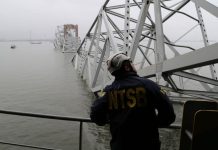
March 26 (UPI) — The seatbelt strap of one of the passengers in a fatal helicopter crash in New York City earlier this month was underneath the fuel lever of the aircraft, the pilot told investigators, a report released Monday said.
The National Transportation Safety Board’s preliminary report into the March 11 crash into Manhattan’s East River detailed how the pilot attempted to crash land the helicopter after the engine failed. It also provided more information into how the five passengers — all of whom died — were harnessed into the aircraft.
The pilot Rich Vance, the lone survivor of the crash, told investigators he twice instructed the passengers on how to use a cutting tool to release themselves from their harnesses in an emergency. But each were unable to do so at the time of the crash and drowned.
Each passenger was restrained in the helicopter two ways — with the helicopter manufacturer’s seatbelt and shoulder harness, and by an aftermarket harness tethered to hard points on the helicopter.
During the flight, the front passenger and the two rear passengers closest to the doorways sat sideways facing outside the helicopter, while the two inboard passengers in the rear removed their seatbelt and sat on the floor of the helicopter with their feet on the aircraft’s skids. Those two passengers remained tethered in their harnesses.
Vance told the NTSB that at one point he noticed the front passenger’s seatbelt was hanging from his seat, and the pilot tapped the passenger and told him to put it back on, which he did.
“During the interview the pilot also recalled that other passengers had inadvertently released their seatbelt during previous flights,” the report said.
Later, as the helicopter flew over Central Park, the pilot said the front-seat passenger turned toward the outside of the aircraft, slid on the bench seat back toward the pilot and extended his feet out the aircraft to take a photo of his feet over the city. At that point, the pilot began to turn toward the south and heard a “low rotor rpm alert in his headset.”
Believing the helicopter’s engine was failing, the pilot told the passengers to get back into their seats and considered where to crash land. He decided on the East River instead of Central Park in order to avoid injuring anyone on the ground.
“At this point he was ‘committed to impact,’ and, when he reached down for the emergency fuel shutoff lever, he realized that it was in the off position. He also noted that a portion of the front seat passenger’s tether was underneath the lever,” the report said.
The pilot turned the fuel shutoff lever back to the “on” position and tried to restart the engine, at which point the engine appeared to respond. He realized, though, it was too late to avoid a crash, so he positioned the fuel shutoff lever back to “off.”
After impact, the pilot said he attempted to detach the front-seat passenger from the helicopter, but was unable to do so.
The pilot “kept his restraint on and reached down for the front seat passenger’s carabiner attachment to the helicopter. He turned the knurled screw ‘two or three rotations;’ by that time, the helicopter was ‘listing past a 45 degree roll.’ He then decided to egress the helicopter, and by the time he unbuckled his restraint, he was fully under water,” the report said.
The pilot then pulled himself out of the helicopter and waved for help.
“Examination of the seats and restraint systems revealed that the five passengers onboard the helicopter were provided with airframe manufacturer-installed restraints, as well as a full body harness. The harness system was not installed by the helicopter manufacturer and was comprised of off-the-shelf components consisting of a nylon fall-protection harness that was attached at the occupants’ back by a locking carabiner to a lanyard,” the report said.
Days after the crash, the parents of one of the victims, Trevor Cadigan, 26, sued the company, Liberty Helicopters, and Vance of failing to ready passengers properly for the possibility of a crash.






